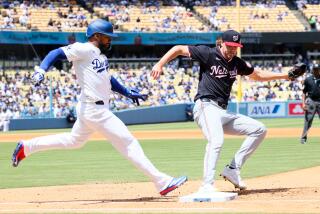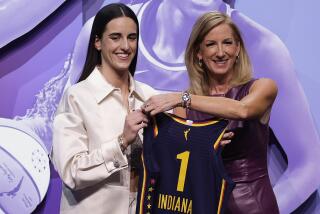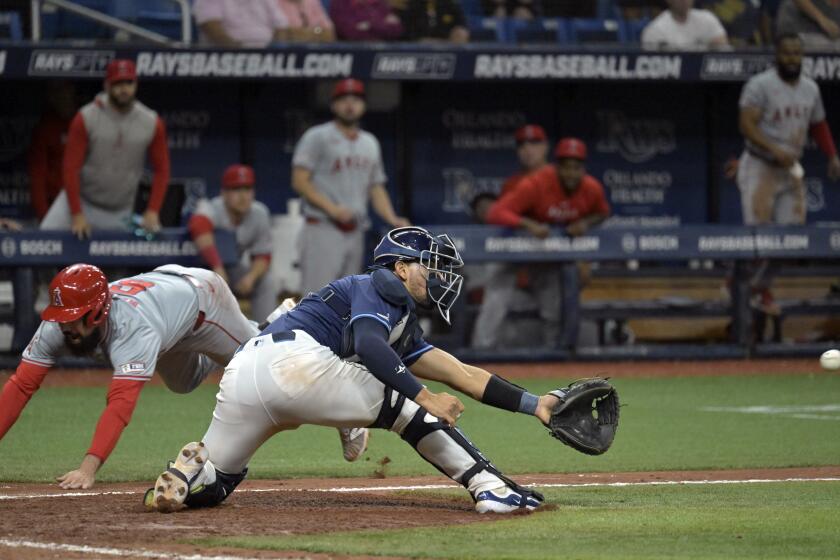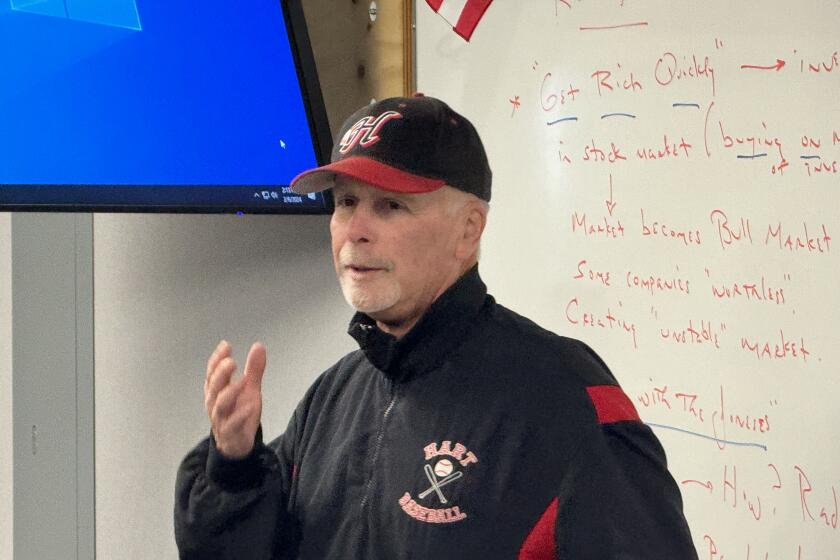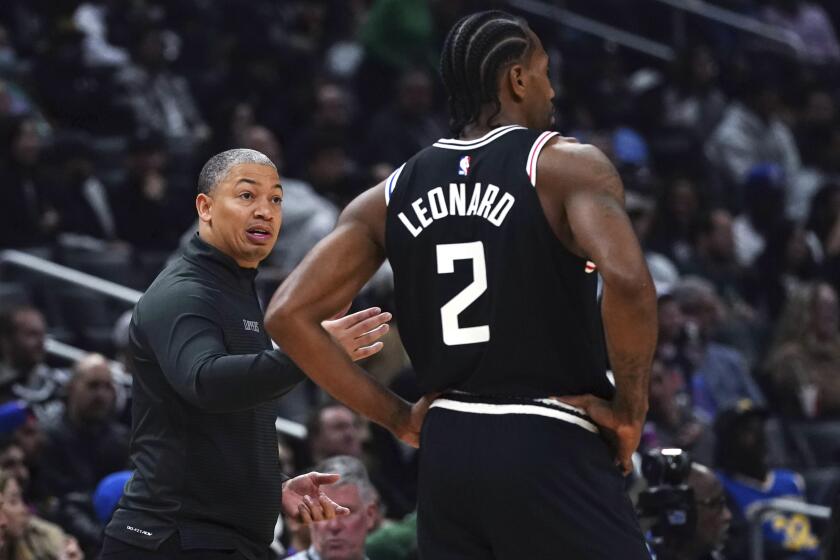Commentary : Failure of Spirit Keeps Padres Back : Baseball: National League’s underachievers have neither the electricity nor the selflessness to win, says a writer who covered the greats.
Like most San Diego Padres fans, I’m frustrated as hell and don’t want to take it any more. Once again, we get to engage in our annual late-summer debate, the one we’ve held over the last couple of years: How can a team with this much talent play this badly? Why do they dog it early in the season, only to shine when the pressure is off and the games are virtually meaningless?
I’ve been in winning locker rooms, lots of them, and, from my vantage point, the Padres don’t know how to win. This team won’t fly another division flag over San Diego Jack Murphy Stadium unless they can develop a winning attitude.
From the late 1940s to the mid-1970s, I covered baseball for several suburban New York dailies, interviewing and befriending such Hall of Famers as Jackie Robinson, Mickey Mantle, Willie Mays, Duke Snider and Casey Stengel.
Sportswriting didn’t pay very much in those days, but that was OK; I wasn’t making much less than the stars I was writing about.
I’ve been retired since moving to San Diego and becoming a Padre fan, so I haven’t really seen firsthand what goes on in and around the local locker room. But I rarely miss a game, and I devour every word written about our boys in the mustard-colored uniforms.
There’s a certain feel, an electricity, about a winning team that’s difficult to put into words. But it’s there, and you know it the moment you walk into the locker room or step on the field. It filled every nook and cranny of Ebbets Field from the day Jackie Robinson joined the Dodgers in 1947 until the team put all of Brooklyn into mourning by moving to Los Angeles.
It permeated every inch of Yankee Stadium since time began, and certainly marked Casey Stengel’s incredible tenure as manager, when he led them to 10 pennants in 12 years between 1949 and 1960.
It was evident at the Polo Grounds when the 1951 Giants wiped out a 13 1/2-game deficit to win in a playoff, and it was at Shea Stadium when the Miracle Mets won it all in 1969 and repeated four years later.
What I saw in those days was players coming to the defense of teammates, whatever the consequences. I can’t forget that steamy 1947 afternoon in St. Louis when Jackie Robinson, a rookie, stood forlornly at his second base position while Cardinal players and fans hurled the vilest of epithets at baseball’s first black player. One brave anonymous Cardinal, hiding in the dugout, went so far as to toss a black cat onto the field while the crowd roared its delight.
What happened next was, I always felt, crucial to Jackie’s career. Pee Wee Reese, another Hall of Famer and one of the most popular players ever to put on a uniform, called time and walked up to Robinson from his shortstop position. When “The Little Colonel” from Kentucky put a reassuring arm around the neck of his new teammate, the attitude of the fans and players seemed to change. The game began, and Brooklyn went on to capture the first of its six pennants during Jackie’s decade.
In 1961, when poor Roger Maris received so much flak from fans and press because he was out-dueling the popular Mickey Mantle in the greatest home-run race of all time, who do you think was Roger’s No. 1 supporter? You got it: Mickey Mantle.
I saw players willing to do anything for the good of the team. Dodger Gil Hodges, who might have become one of the finest catchers in baseball, gladly moved to first base to make room for a kid named Roy Campanella. Yankee Elston Howard, another outstanding catcher, happily played outfield and first base for five years until a funny-looking guy named Yogi Berra slowed down a bit.
After the Reds’ Pete Rose tangled with Met Bud Harrelson during the 1973 playoffs, it was amazing how Met pitchers thought Rose’s head looked like the strike zone.
Now let’s look at the 1990 Padres.
When was the last time you saw a San Diego pitcher protect one of his players? Think hard! When Benito Santiago was decked by Giant pitcher Jeff Brantley, sidelining one of the team’s top hitters, did the Padres retaliate? Hardly. Not only was Brantley spared a brushback pitch in his next at-bat, he even got a base hit. Three more Padres were hit in their next series with the Giants, and the Padre pitchers still did nothing.
I’m not condoning head-hunting. I don’t want to see anyone hurt. I’d just like to see a little more competitive fire from an obviously talented group of ballplayers.
Maybe players today make too much money to sacrifice personal glory for victories. Not long ago, second baseman Roberto Alomar (salary $390,000) was asked to try playing shortstop for the good of the team. Robbie made his displeasure known and the experiment was over almost before it began.
If there’s one Padre who has a winning attitude and could fit right in with the scrappy teams of yesteryear, it’s Tony Gwynn. His work ethic has already earned him four batting titles and three Gold Gloves. I’ll bet he’d rush out to pitch batting practice if someone asked him to.
So what did Mike Pagliarulo do? The obscure Yankee castoff put on a San Diego uniform, sat down with an old New York sportswriter friend of his, and bad-mouthed the best player ever to represent this city--in the name of firing up the club. What made the act so reprehensible is that not a single Padre--not one--stood up and came to Tony’s defense. The team won for a while, but then came the annual swoon. Things haven’t been the same since.
Without that kind of loyalty, that us-against-the-world mentality, baseball clubs don’t win. Nine men playing highly individualized roles need that intangible something to meld them into a team. Whatever it is, these guys don’t have it.
More to Read
Get our high school sports newsletter
Prep Rally is devoted to the SoCal high school sports experience, bringing you scores, stories and a behind-the-scenes look at what makes prep sports so popular.
You may occasionally receive promotional content from the Los Angeles Times.

